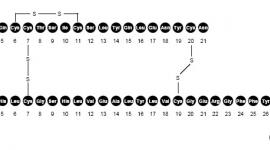Amaryl Diabetes Type 2 Treatment - Amaryl Patient Information
Brand names: Amaryl
Generic name: Glimepiride
Amaryl, Glimepiride, Full Prescribing Information
What is Amaryl and why is Amaryl prescribed?
Amaryl is an oral medication used to treat type 2 (non-insulin-dependent) diabetes when diet and exercise alone fail to control abnormally high levels of blood sugar. Like other diabetes drugs classified as sulfonylureas, Amaryl lowers blood sugar by stimulating the pancreas to produce more insulin. Amaryl is often prescribed along with the insulin-boosting drug Glucophage. It may also be used in conjunction with insulin and other diabetes drugs.
Most important fact about Amaryl
Always remember that Amaryl is an aid to, not a substitute for, good diet and exercise. Failure to follow a sound diet and exercise plan may diminish the results of Amaryl and can lead to serious complications such as dangerously high or low blood sugar levels. Remember, too, that Amaryl is not an oral form of insulin, and cannot be used in place of insulin.
How should you take Amaryl?
Do not take more or less of Amaryl than directed by your doctor. Amaryl should be taken with breakfast or the first main meal.
- If you miss a dose...
Take it as soon as you remember. If it is almost time for the next dose, skip the one you missed and go back to your regular schedule. Do not take 2 doses at the same time. - Storage instructions...
Amaryl should be stored at room temperature in a well-closed container.
What side effects may occur?
Side effects cannot be anticipated. If any develop or change in intensity, tell your doctor as soon as possible. Only your doctor can determine if it is safe for you to continue taking Amaryl.
- Side effects may include:
Anemia and other blood disorders, blurred vision, diarrhea, dizziness, headache, itching, liver problems and jaundice, muscle weakness, nausea, sensitivity to light, skin rash and eruptions, stomach and intestinal pain, vomiting
Amaryl, like all oral antidiabetics, can result in hypoglycemia (low blood sugar). The risk of hypoglycemia can be increased by missed meals, alcohol, fever, injury, infection, surgery, excessive exercise, and the addition of other medications such as Glucophage or insulin. To avoid hypoglycemia, closely follow the dietary and exercise regimen suggested by your doctor.
- Symptoms of mild low blood sugar may include:
Blurred vision, cold sweats, dizziness, fast heartbeat, fatigue, headache, hunger, light-headedness, nausea, nervousness - Symptoms of more severe low blood sugar may include:
Coma, disorientation, pale skin, seizures, shallow breathing
Ask your doctor what steps you should take if you experience mild hypoglycemia. If symptoms of severe low blood sugar occur, contact your doctor immediately; severe hypoglycemia is a medical emergency.
Why should Amaryl not be prescribed?
Avoid Amaryl if you have ever had an allergic reaction to it.
Do not take Amaryl to correct diabetic ketoacidosis (a life-threatening medical emergency caused by insufficient insulin and marked by excessive thirst, nausea, fatigue, and fruity breath). This condition should be treated with insulin.
Special warnings about Amaryl
It's possible that drugs such as Amaryl may lead to more heart problems than diet treatment alone, or treatment with diet and insulin. If you have a heart condition, you may want to discuss this with your doctor.
When taking Amaryl, you should check your blood and urine regularly for abnormally high sugar (glucose) levels. The effectiveness of any oral antidiabetic, including Amaryl, may decrease with time. This may occur because of either a diminished responsiveness to the medication or a worsening of the diabetes.
Even people with well-controlled diabetes may find that stress such as injury, infection, surgery, or fever triggers a loss of control. If this happens, your doctor may recommend that you add insulin to your treatment with Amaryl or that you temporarily stop taking Amaryl and use insulin instead.
Possible food and drug interactions when taking Amaryl
If Amaryl is taken with certain other drugs, the effects of either could be increased, decreased, or altered. It is especially important to check with your doctor before combining Amaryl with the following:
- Airway-opening drugs such as albuterol sulfate
- Aspirin and other salicylate medications
- Chloramphenicol
- Corticosteroids such as prednisone
- Diuretics such as hydrochlorothiazide and chlorothiazide
- Estrogens such as conjugated estrogens
- Heart and blood pressure medications called beta blockers, including atenolol, metoprolol tartrate, and propranolol hydrochloride
- Isoniazid
- Major tranquilizers such as thioridazine hydrochloride
- MAO inhibitors (antidepressants such as phenelzine sulfate and tranylcypromine sulfate)
- Miconazole
- Nicotinic acid
- Nonsteroidal anti-inflammatory drugs such as diclofenac sodium, ibuprofen, mefenamic acid, and naproxen
- Oral contraceptives
- Phenytoin
- Probenecid
- Sulfa drugs such as sulfamethoxazole and trimethoprim
- Thyroid medications such as levothyroxine
- Warfarin
- Use alcohol with care; excessive alcohol intake can cause low blood sugar.
Special information if you are pregnant or breastfeeding
Do not take Amaryl while pregnant. Since studies suggest the importance of maintaining normal blood sugar levels during pregnancy, your doctor may prescribe injected insulin instead. Drugs similar to Amaryl do appear in breast milk and may cause low blood sugar in nursing infants. You should not take Amaryl while nursing. If diet alone does not control your sugar levels, your doctor may prescribe injected insulin.
Recommended dosage for Amaryl
ADULTS
The usual starting dose is 1 to 2 milligrams taken once daily with breakfast or the first main meal. The maximum starting dose is 2 milligrams.
If necessary, your doctor will gradually increase the dose 1 or 2 milligrams at a time every 1 or 2 weeks. Your diabetes will probably be controlled on 1 to 4 milligrams a day; the most you should take in a day is 8 milligrams. If the maximum dose fails to do the job, your doctor may add Glucophage to your regimen.
Weakened or malnourished people and those with adrenal, pituitary, kidney, or liver disorders are particularly sensitive to hypoglycemic drugs such as Amaryl and should start at 1 milligram once daily. Your doctor will increase your medication based on your response to the drug.
CHILDREN
Safety and effectiveness in children have not been established.
Overdosage
An overdose of Amaryl can cause low blood sugar (see "What side effects may occur?" for symptoms).
Eating sugar or a sugar-based product will often correct mild hypoglycemia. For severe hypoglycemia, seek medical attention immediately.
last updated 10/2008
Amaryl, Glimepiride, Full Prescribing Information
Detailed Info on Signs, Symptoms, Causes, Treatments of Diabetes
back to: Browse all Medications for Diabetes
APA Reference
Staff, H.
(2008, October 30). Amaryl Diabetes Type 2 Treatment - Amaryl Patient Information, HealthyPlace. Retrieved
on 2025, November 29 from https://www.healthyplace.com/diabetes/medications/amaryl-type-2-diabetes-information

